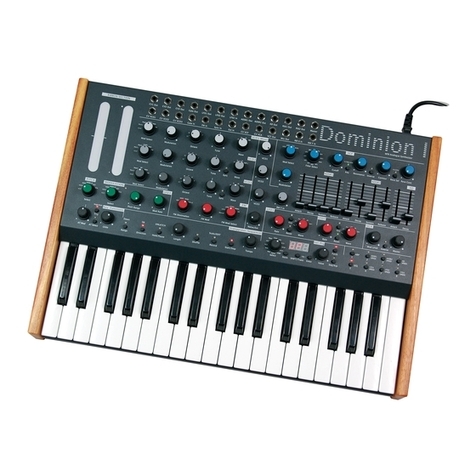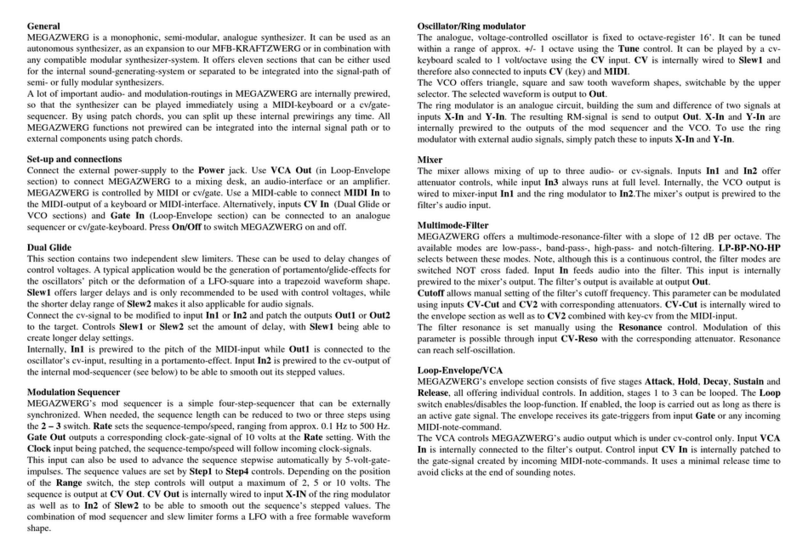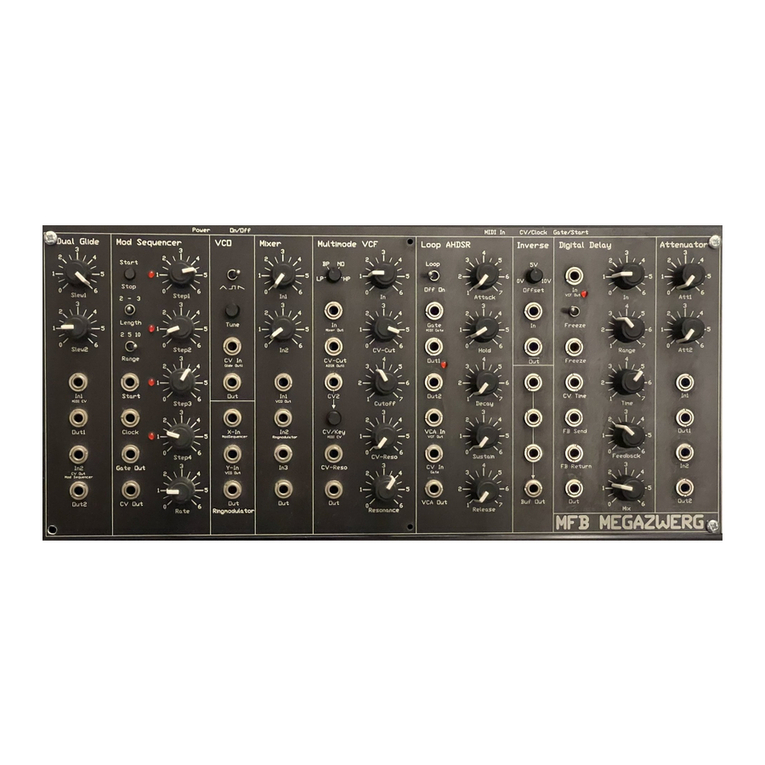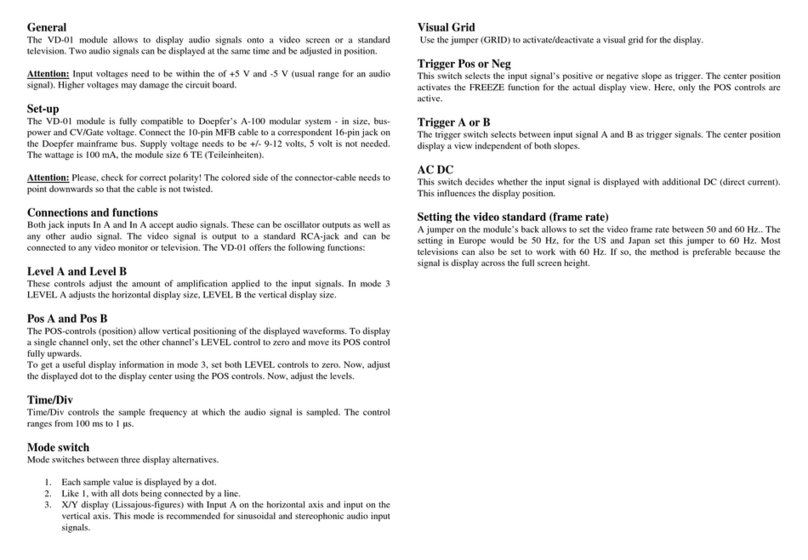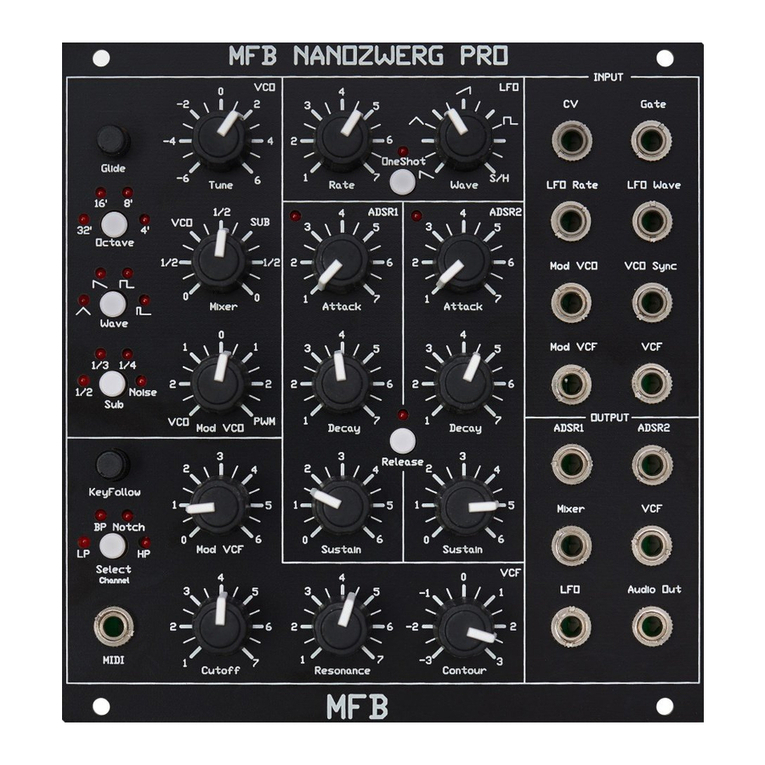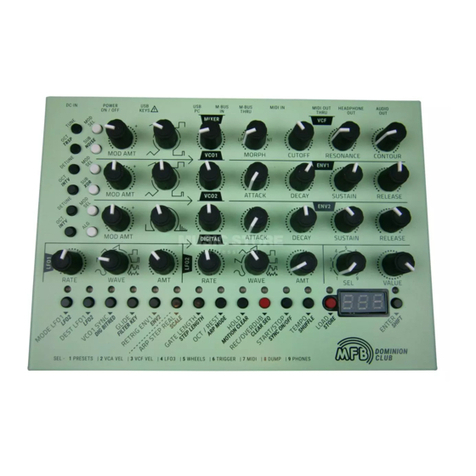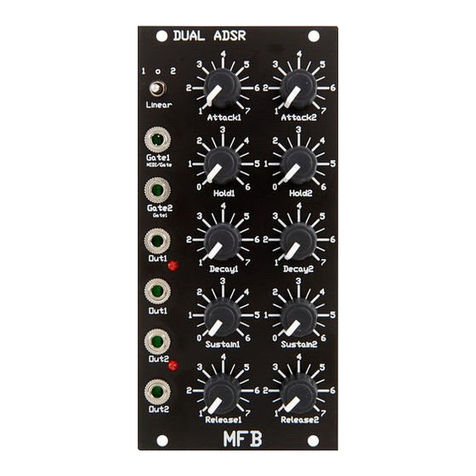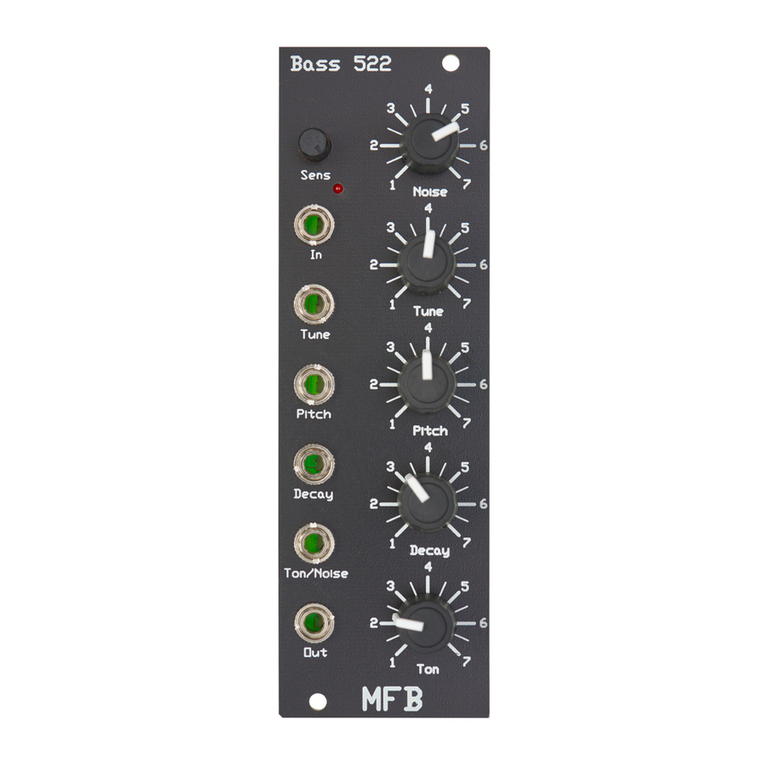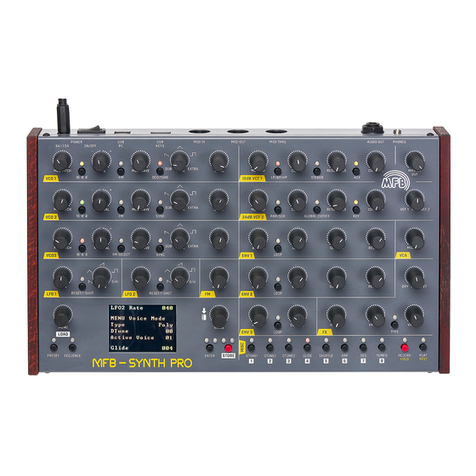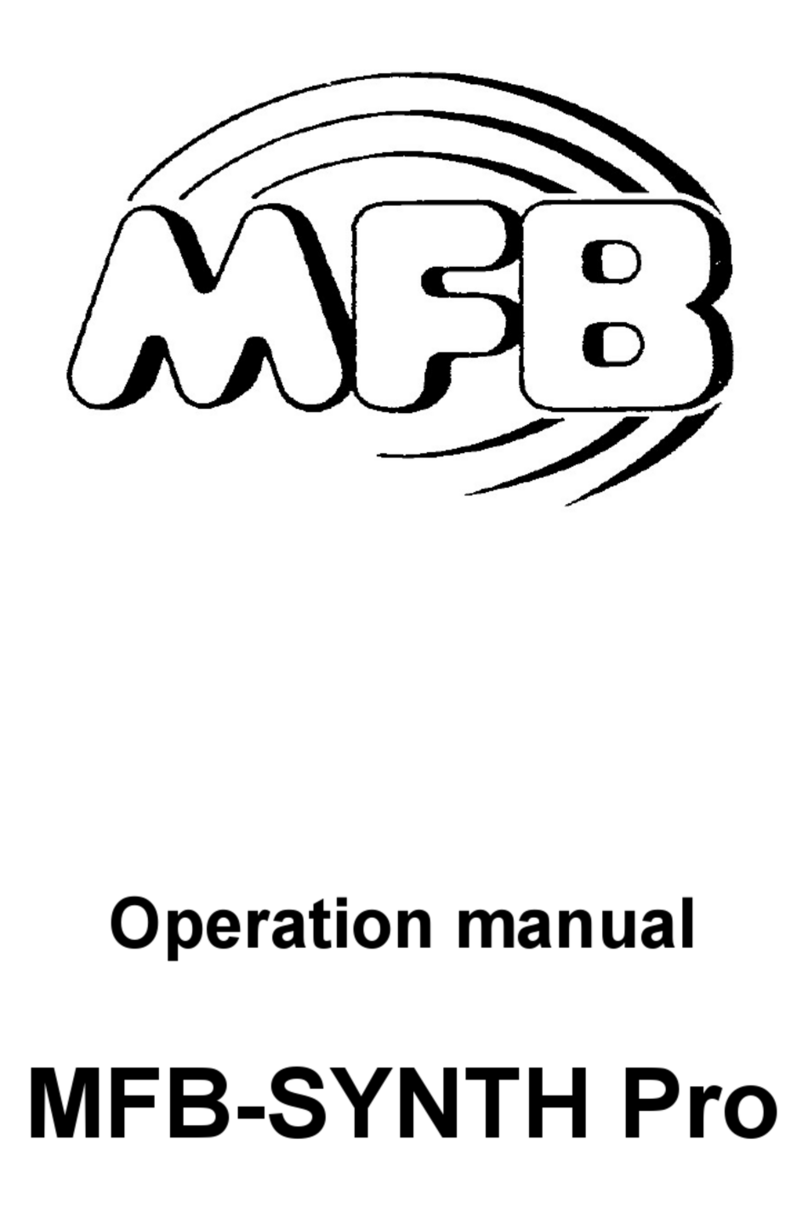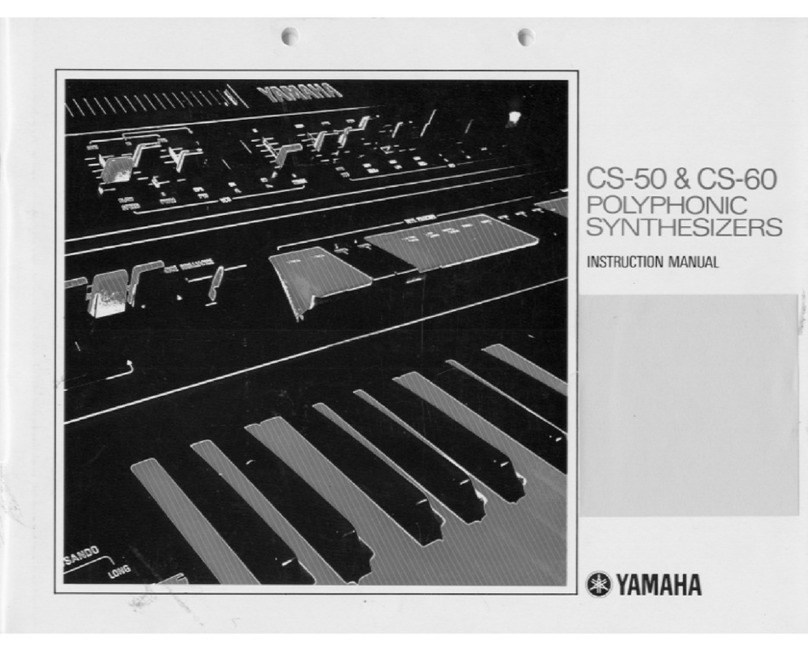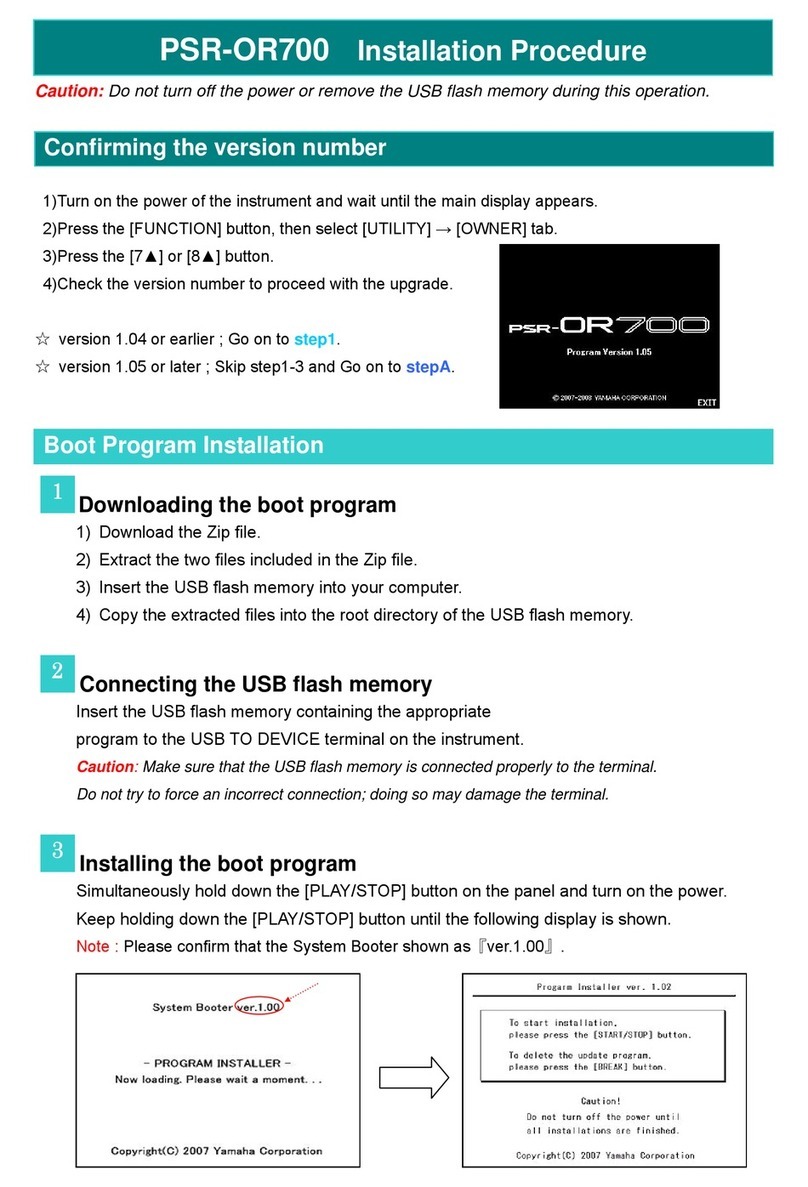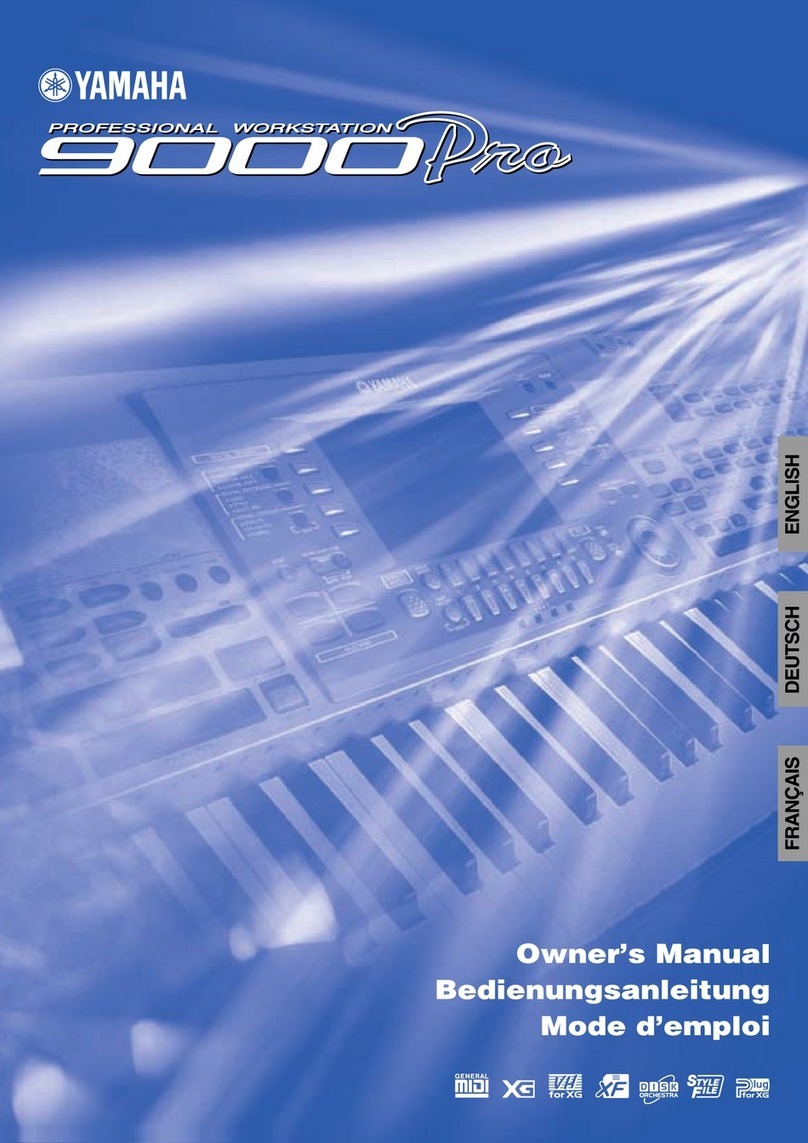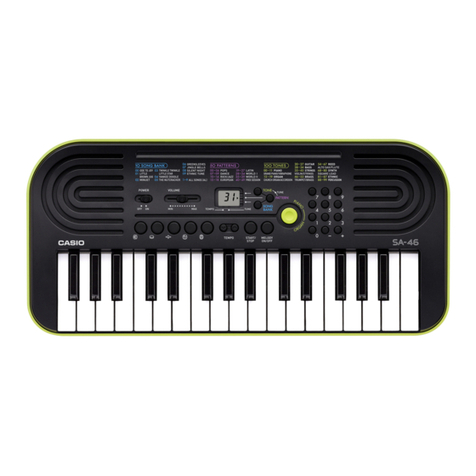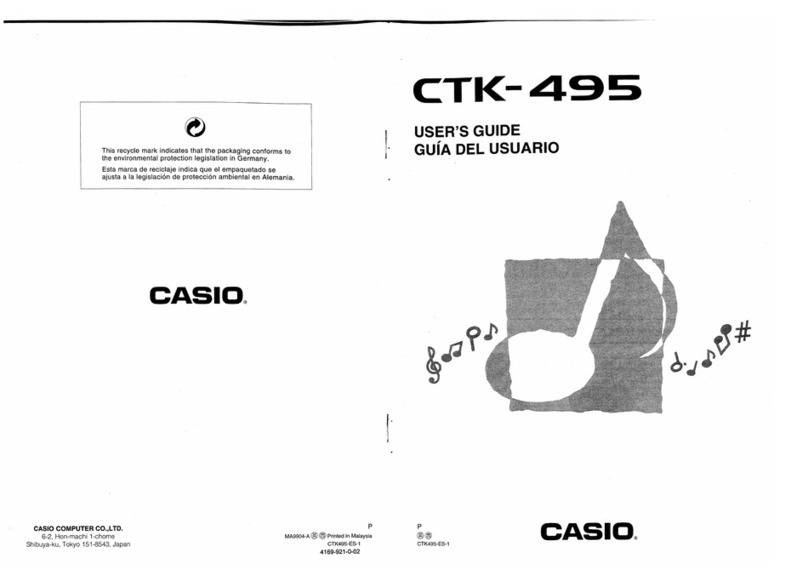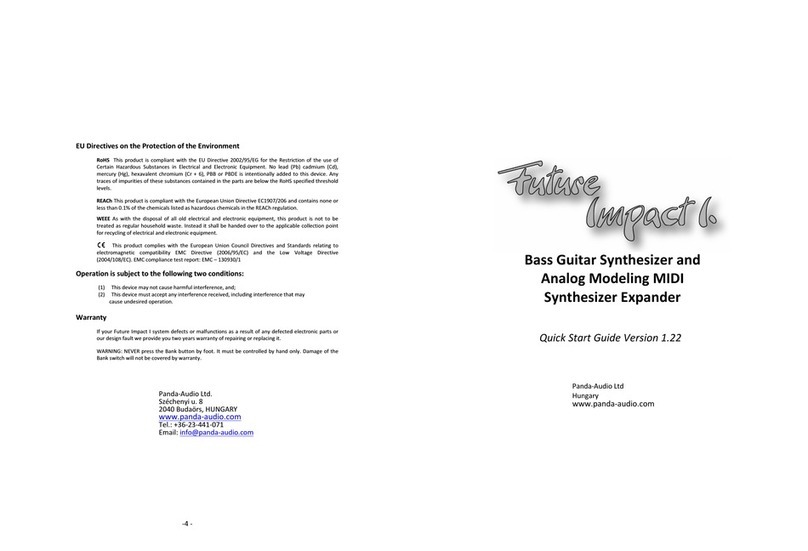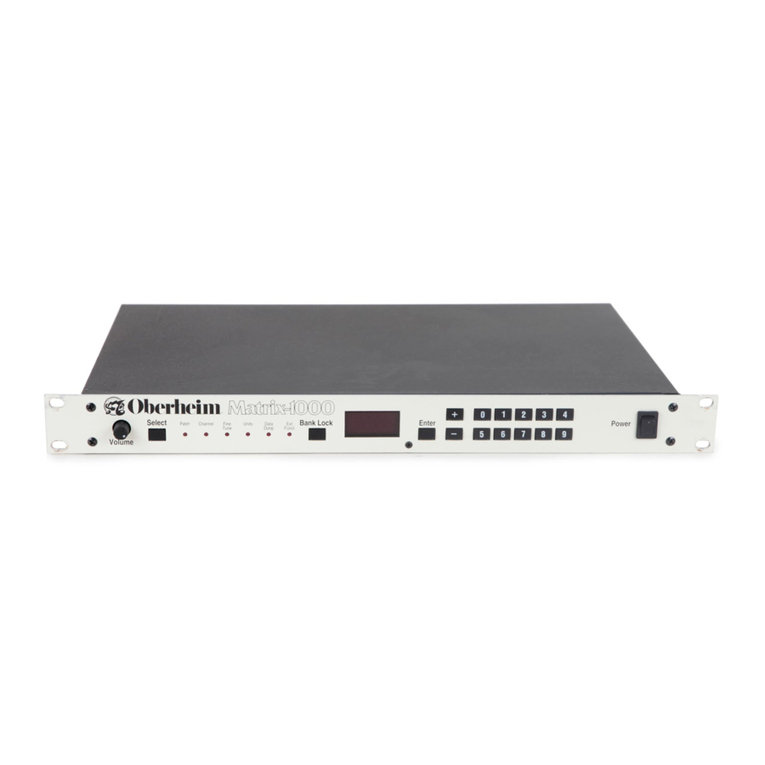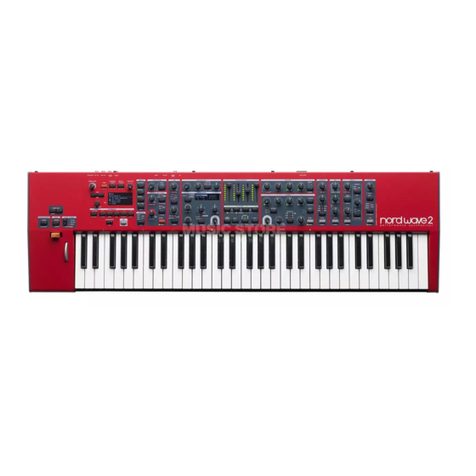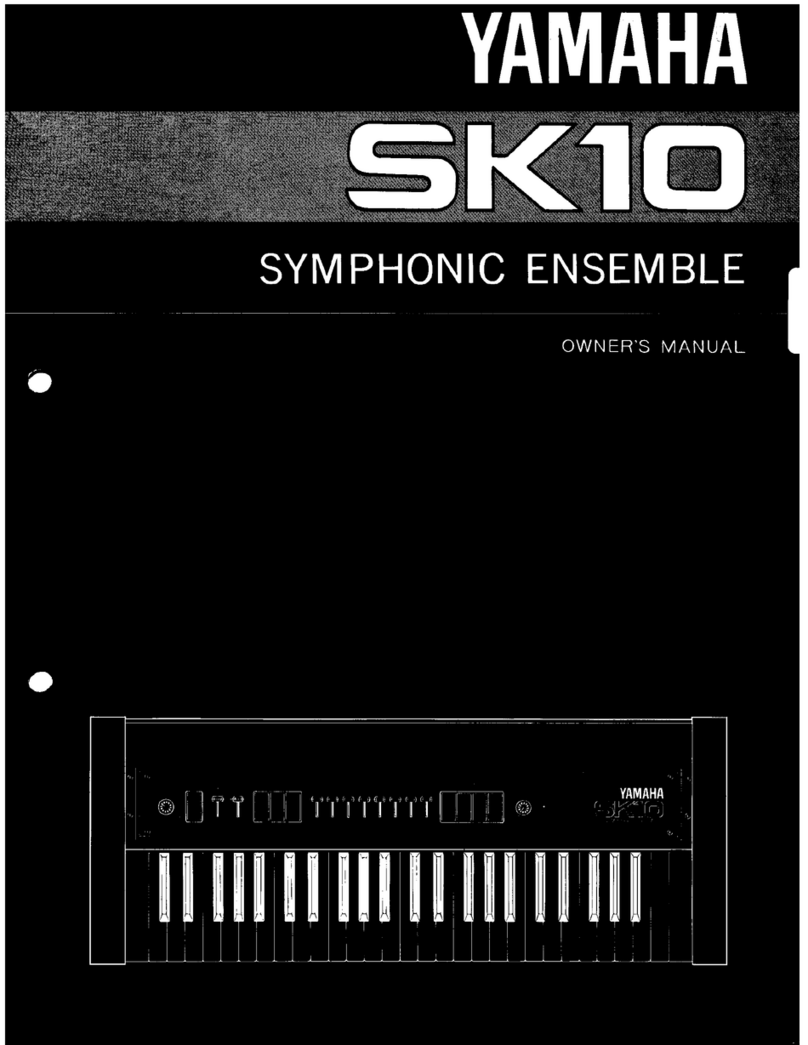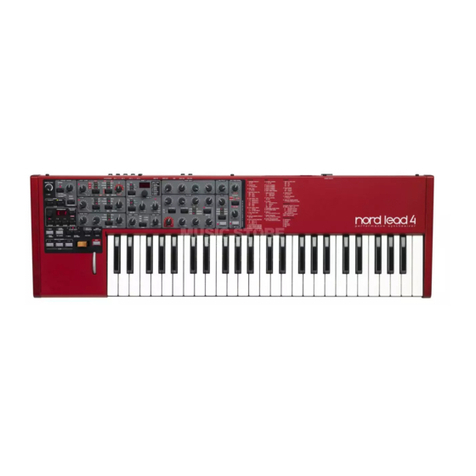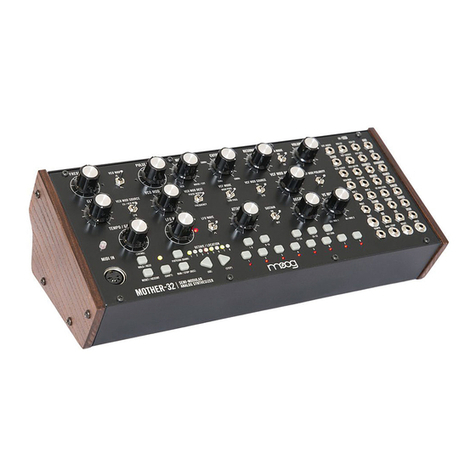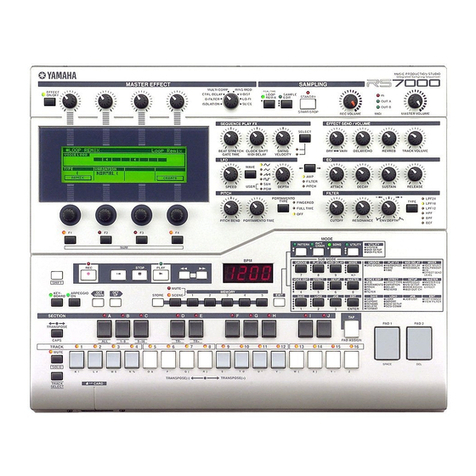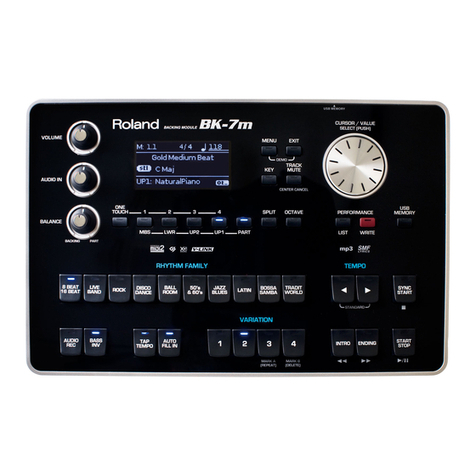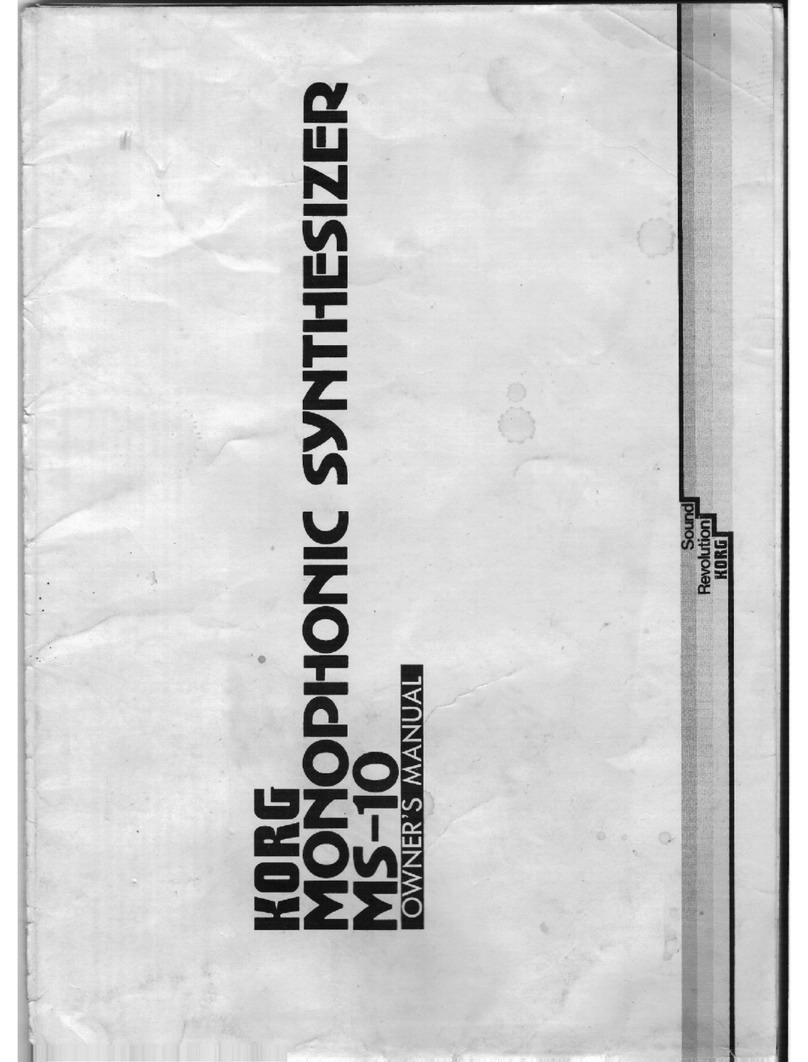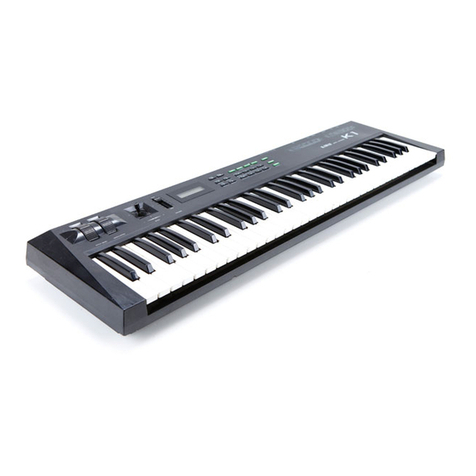MFB NANOZWERG User manual

General
NANOZWERG is a monophonic, analogue synthesizer in desktop format that can be
controlled by MIDI as well as analogue CV- and Gate voltages. It includes all typical
elements of subtractive synthesis and is suited for classic bass- and lead-sounds as well as
effect-sounds. In addition, NANOZWERG can be used a filter box for external line-level-
audio-sources.
Set-up and connections
Connect the external power-supply to the Power jack. Use AudioOut to connect
NANOZWERG to a mixing desk, an audio-interface or an amplifier. AudioIn allows an
external audio-signal (line level) to be fed into the units signal path to be used as a filter
box, e.g. for a drum machine. NANOZWERG is controlled by MIDI or CV/Gate. Use a
MIDI-cable to connect MIDI In with the MIDI-output of a keyboard or MIDI-interface.
Alternatively, inputs CV In and Gate In can be connected to an analogue sequencer or
CV/Gate-keyboard. Press On/Off to switch NANOZWERG on and off.
Attention: NANOZWERG uses analogue components. To ensure stable tuning, make sure
the unit is switched on for 5-10 minutes before your performance starts.
Oscillators (VCO & Sub OSC)
NANOZWERG features a VCO with an additional sub oscillator. The VCO offers four
waveform shapes that are selected by pressing Wave: triangle, saw tooth, rectangle and
impulse. Octave sets the base octave to 16’, 8’, 4’ or 2’. Tune controls the tuning within a
continuous range of +/- one octave.
The sub oscillator generates a rectangle-wave one or two octaves below the VCO’s tuning.
Use Sub OSC to toggle between the settings 1/2, 1/4 or Mix. With Mix selected, 1/2, 1/4
and an additional 5/8 will sound simultaneously. Alternatively, the rectangle signal can be
replaced by a noise generator (Noise setting). Mixer adjusts the balance between VCO and
Sub OSC.
The fifth position of Sub OSC deactivates the sub oscillator. With the sub oscillator being
deactivated and the Mixer set to Sub OSC fully, NANOZWERG can be used to process
external audio source exclusively.
The VCO can be modulated by the LFO. By turning Mod2 left from center, the pitches of
VCO and Sub OSC are modulated. Turning right from center will address the symmetry
(pulse width) of the impulse-waveform. The center position will deactivate modulation.
Glide
The trim control Glide sets the time for a continuous glide of two adjacent played notes
(Portamento).
Filter (VCF)
The 12-dB multimode-filter allows sonic shaping of oscillator, sub oscillator and the
external audio input. It offers four modes, selectable by pressing Select: Lowpass (LP),
Bandpass (BP), Band Reject (Notch) and Highpass (HP).
The cutoff frequency is adjusted using the Cutoff control. In addition, this parameter can
also be controlled by other sources: The trim pot Key Follow sets the dependency between
cutoff and incoming notes (MIDI, Key-CV).
Contour adjusts the control of the ADSR-envelope towards the cutoff frequency. This
parameter works bidirectional: Turning right from center has a positive influence, while
turning left from center inverts the envelope influence. There is no envelope modulation in
the center position of this knob.
Turning Mod1 left from center will introduce a continuous modulation of the filter’s cutoff
by the VCO (Filter-FM). Turning right from center will introduce modulation by the LFO.
There is no modulation in the knob’s center position.
In addition, the cutoff frequency can be controlled by external sources. VCF In is a CV-
input that could be addressed by a step-sequencer for example. MIDI-control over cutoff is
done using CC #1 (modulation wheel).
Resonance sets the emphasis (Q-factor) of the filter at the current cutoff frequency. At its
maximum, self-oscillation can be reached.
Amplifier (VCA)
The final element in the signal path is a voltage-controlled amplifier. This VCA is either
controlled by a gate or envelope-signal that is triggered by MIDI- or gate-input signals.
VCA Select toggles between these modes. With Gate lid, the corresponding LED for the
VCA is lit for the duration of the note-signal. The amplifier is open fully for this period.
Gate-mode uses a minimal release-time to avoid unwanted clicking at the sound’s end.
When using the envelope, the volume will follow the parameter progression.
The VCA can also be externally controlled, using the VCA In input. Use any compatible
CV-voltage source like another envelope from a modular synthesizer system.
Envelope (ADSR)
The envelope generator offers control for Attack-time, Decay-time, Sustain-level and
Release-time. The first three phases work, while a note at the MIDI- or Gate-input is
active. The release-time starts when a note/gate-signal has stopped.
Modulation-oscillator (LFO)
The LFO offers four waveform shapes: triangle, saw tooth, rectangle and S/H (Sample &
Hold). Rate sets the LFO’s frequency (speed) between approx. 10 seconds and 100 Hz.
Pressing OneShot activates a one-pass-mode, where the selected waveforms is only played
once after a note-trigger input is received.

Sequencer
NANOZWERG offers four, short internal sequences. Sequence 4 is a continuous note that
permanently opens the VCA. This mode is ideally-suited to use NANOZWERG as a filter
box for external audio signals, where MIDI- or gate-signals are not available to trigger the
VCA.
The sequencer is controlled by knobs in the LFO-section as well as buttons of the VCO-
and VCA-sections. To start a sequence, press and hold OneShot (LFO), followed by one
of the buttons to the left (VCA Select, Octave, Wave, Sub OSC).
The sequence speed is set by the LFO Rate control, while OneShot (LFO) is being
pressed. The sequence can be transposed using a MIDI- or CV-keyboard. Stop the
sequence by pressing and holding OneShot (LFO) combined with the button for the
selected sequence (VCA Select, Octave, Wave, Sub OSC).
MIDI
NANOZWERG receives MIDI-notes over a five-octave-range (C1-C6). In addition, it
accepts MIDI-data for pitch-wheel (+/- 2 semitones) and mod-wheel data (MIDI-CC #1)
that address the filter’s cutoff frequency as well as the LFO speed.
MIDI-Channel
To set the MIDI-channel, press and hold Wave (LFO) for approx. one second. Keep the
button pressed and set the channel using the Rate control. The channel number is
displayed using the LEDs next to the LFO-wave. Add up the numbers next to the LEDs to
determine the current channel (e.g. 1+4 = channel 5, 1+2+8 = channel 11). With no LED
lit, the MIDI channel is 16.
Accent
The accent-function is activated by pressing VCA Select and Select in the VCF section,
instead of mod_wheel). This velocity-activated function will simultaneously affect the
filter’s cutoff frequency, the LFO’s speed (as well in one-shot-mode as an envelope) as
well as the VCA.
Connections
The audio in- and outputs are located on the top of NANOZWERG. The connectors for
external control can be found on the unit’s rear. MIDI- and CV-/Gate In are meant to be
used by keyboards or sequencers. VCF In and VCA In are meant to be used for
modulations by external CV-sources, as described earlier.
Hint: The input LFO In is a specialty: Connecting an external source does not only
modulate the LFO’s speed. It will also increase its range significantly. With CV-voltages
of up to 10 volts, the maximal speed reaches the audio spectrum, up to approx. 3 kHz.
Using this function, the LFO when controlled by an analogue sequencer might be used as a
second oscillator. Its signal needs to be tapped at the LFO Out jack and fed back into the
unit using the AudioIn input (the signal will join with the VCO and sub oscillator signals
before the filter section).
Owner’s manual
MFB-NANOZWERG
Other MFB Synthesizer manuals
